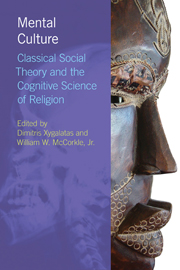Book contents
- Frontmatter
- Contents
- List of illustrations
- Contributors
- 1 Introduction: social minds, mental cultures – weaving together cognition and culture in the study of religion
- 2 Explanatory pluralism and the cognitive science of religion: why scholars in religious studies should stop worrying about reductionism
- 3 Early cognitive theorists of religion: Robin Horton and his predecessors
- 4 The opium or the aphrodisiac of the people? Darwinizing Marx on religion
- 5 Immortality, creation and regulation: updating Durkheim's theory of the sacred
- 6 Non-ordinary powers: charisma, special affordances and the study of religion
- 7 Malinowski's magic and Skinner's superstition: reconciling explanations of magical practices
- 8 Towards an evolutionary cognitive science of mental cultures: lessons from Freud
- 9 Piaget on moral judgement: towards a reconciliation with nativist and sociocultural approaches
- 10 Building on William James: the role of learning in religious experience
- 11 Explaining religious concepts: Lévi-Strauss the brilliant and problematic ancestor
- 12 The meaningful brain: Clifford Geertz and the cognitive science of culture
- 13 Cognitive science and religious thought: the case of psychological interiority in the Analects
- 14 Conclusion: moving towards a new science of religion; or have we already arrived?
- Bibliography
- Index
10 - Building on William James: the role of learning in religious experience
- Frontmatter
- Contents
- List of illustrations
- Contributors
- 1 Introduction: social minds, mental cultures – weaving together cognition and culture in the study of religion
- 2 Explanatory pluralism and the cognitive science of religion: why scholars in religious studies should stop worrying about reductionism
- 3 Early cognitive theorists of religion: Robin Horton and his predecessors
- 4 The opium or the aphrodisiac of the people? Darwinizing Marx on religion
- 5 Immortality, creation and regulation: updating Durkheim's theory of the sacred
- 6 Non-ordinary powers: charisma, special affordances and the study of religion
- 7 Malinowski's magic and Skinner's superstition: reconciling explanations of magical practices
- 8 Towards an evolutionary cognitive science of mental cultures: lessons from Freud
- 9 Piaget on moral judgement: towards a reconciliation with nativist and sociocultural approaches
- 10 Building on William James: the role of learning in religious experience
- 11 Explaining religious concepts: Lévi-Strauss the brilliant and problematic ancestor
- 12 The meaningful brain: Clifford Geertz and the cognitive science of culture
- 13 Cognitive science and religious thought: the case of psychological interiority in the Analects
- 14 Conclusion: moving towards a new science of religion; or have we already arrived?
- Bibliography
- Index
Summary
The great accomplishment of The Varieties of Religious Experience, William James's enduring classic, was to demonstrate that people come to faith not just because they decide that the propositions are true but because they experience God directly. They feel God's presence. They hear God's voice. Their hearts flood with an incandescent joy. Moreover, these feelings and sensations are patterned. Despite the deep idiosyncracies of personality and life path, when people feel and sense the divine, they do so in ways that can be detailed like a naturalist observing the flight of birds. James set out to describe these features. It is a brilliant book. But it missed the role that spiritual training can plan in encouraging the experience.
In fact, The Varieties of Religious Experience deliberately downplays the role of practice. Prayer is given the most cursory of mentions. There is scant attention to spiritual discipline. The book is about what people experience, not how they get there. James gives the impression that it is these powerful experiences which come, spontaneously, out of nowhere, that become the presence of God for individuals. It is their unwilled quality, their unsought-for surprise, that is so compelling. They come as if from without, and it is the apparent authority that becomes evidence for the external presence of the divine. Here the most famous and dramatic example is the mystical experience, one of whose central characteristics is passivity.
- Type
- Chapter
- Information
- Mental CultureClassical Social Theory and the Cognitive Science of Religion, pp. 145 - 163Publisher: Acumen PublishingPrint publication year: 2013



